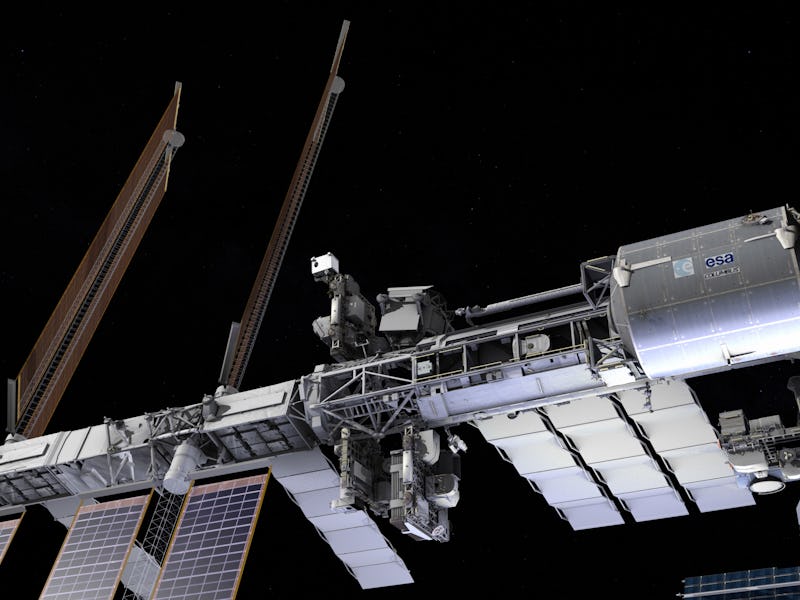There are some objects in the universe that just don’t make sense, and our current technology isn’t advanced enough to help. But, on June 1 at 5:55 p.m. Eastern time, a SpaceX Falcon 9 rocket will be launching a mission to the International Space Station that will be able to see these rare forms with insane precision for the first time ever.
NASA’s NICER, Neutron Star Interior Composition Explorer, will be a finely tuned spectrometer with 56 telescopes that are capable of spotting the thermal and non-thermal emissions of neutron stars in the distant universe. It will do so by scanning with a soft X-ray Timing Instrument, which will be able to see the inner-workings of these complex objects to understand the forces that create them.
An artist's concept of the 56 telescopes on the NICER mission.
A neutron star is classified as a rapidly rotating stellar mass that is the result of a supernova explosion of a giant star. The star essentially collapses at the core and crushes the star’s matter of electrons, protons, and neutrons into a tiny sphere the size of a city. Neutron stars are so densely packed, that they are the densest objects in the universe, about 1.4 times the mass of our sun or 460,000 Earths combined. All that densely packed matter causes a neutron star to become very hot, roughly 1.8 million degrees Fahrenheit. Therefore, they are so bright, they are impossible to see in visible light. X-ray, however, allows scientists to peer into the structures without getting blinded.
There are two main types of neutron stars: pulsars and magnetars. NICER will mostly focus on pulsars, which are spinning jellyfish like objects that project two beams from their highly-magnetized cores. These beams rotate around the neutron like a lighthouse, so the beams go in and out of visibility from Earth, making them appear like they are pulsing or flickering. Most pulsars, like the brightest pulsar X-1, are accompanied by a smaller dwarf star, which the pulsar feeds off of in a process called “accretion.”
This shedding process gives the pulsar its intense brightness and magnetic pull, causing it to spin faster and faster. It was also recently discovered that some pulsars can orbit black holes, like PSR B1820-30A, which can feed the pulsar and nearby globular clusters of stars.
This is an artist's concept of a pulsar pulling in matter from a nearby star in a process known as accretion.
NICER will be measuring the size and density of pulsars to understand how the particles interact with each other. But, beyond these more basic measurements, NICER has two main missions. It will track their pulsing beams, which scientists believe can act as a cosmic clock, keeping a steady rhythm of time for as long as the object lives. And because pulsars are available throughout space, they are ideal subjects for not only time-keeping but navigation. For this reason, NASA believes that pulsars may help us travel through deep space one day, like a kind of X-ray GPS.
“Our primary goal is science,” Keith Gendreau, a scientist at NASA’s Goddard Space Flight Center, says. “But we can use the same pulsar measurements to demonstrate X-ray navigation. It’s rare that we scientists get to develop a multi-purpose experiment such as this one. It’s all coming together.”
But, even cooler than a star navigator is the second mission of NICER, which is basically acting as a testbed for XCOM, which will potentially be able to send data over x-ray wavelengths from one interplanetary spacecraft to another. NICER will be monitoring the pulsations, understanding how the X-rays travel across the universe, collecting information that will eventually lead to a device, called the Modulated X-ray Source, or MXS. The MXS would mimic a pulsar’s twisting beams by generating X-rays with rapidly varying intensity, turning on and off many times per second. Theses pulses would be able to transmit data across far distances — this is some Star Trek level stuff — like the Apple Cloud or Google Drive for space!
“This is a very interesting experiment that we’re doing on the space station,” Gendreau says. “We’ve had a lot of great support from the science and space technology folks at NASA Headquarters. They have helped us advance the technologies that make NICER possible as well as those that NICER will demonstrate. The mission is blazing trails on several different levels.”
NICER will be retrofitted to the exterior of the ISS where it will sit on a rotating platform to track pulsar wavelengths across the universe. The mission will last for 18 months.
